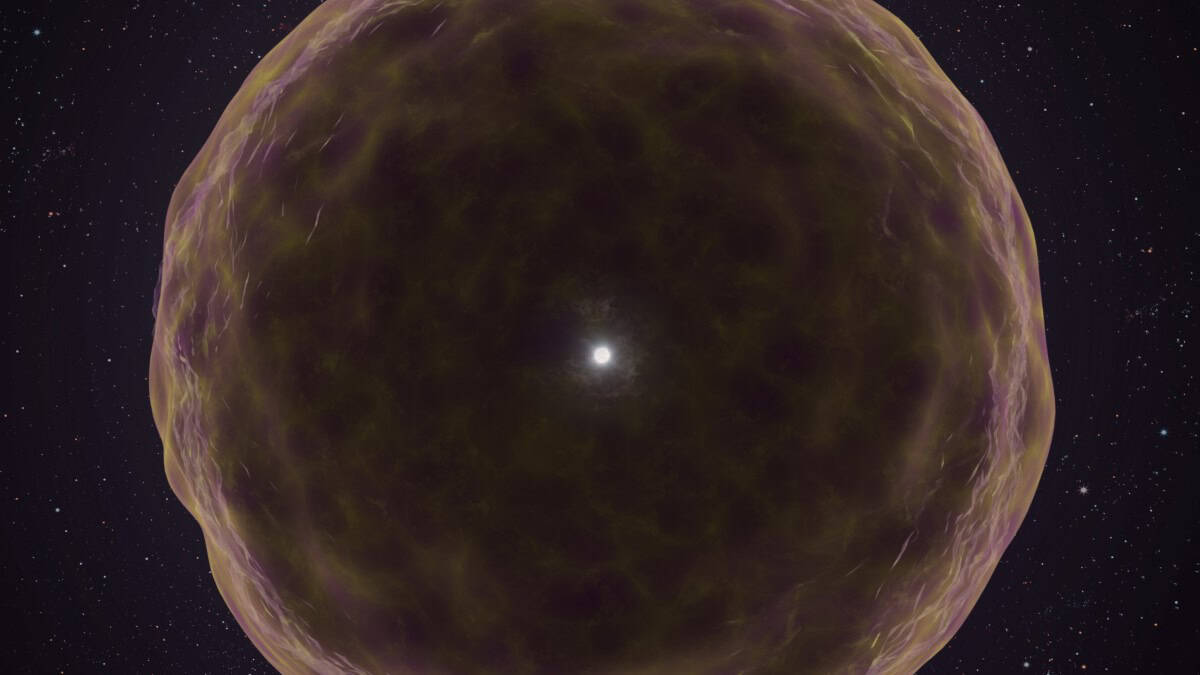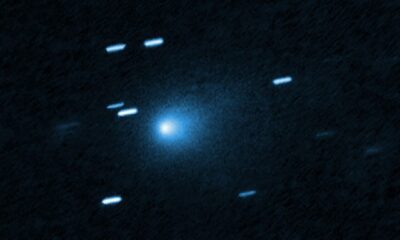Science
Astronomers Discover Heavily Stripped Star Before Supernova

Astronomers have uncovered significant evidence of a heavily stripped star that shed its outer layers prior to a supernova explosion. This discovery, led by Steve Schulze from Northwestern University, reveals spectral signatures of heavier elements typically found deep within stellar interiors.
As stars evolve, they undergo a process called nucleosynthesis, where atomic nuclei fuse to create heavier elements, releasing energy that counteracts gravitational collapse. Initially composed mostly of hydrogen, stars evolve through successive layers, producing helium, carbon, and eventually iron. At this later stage, iron does not release energy during fusion, leading to an inevitable gravitational collapse and a dramatic supernova event.
The rare observation of a star expelling its outer layers before such an explosion has allowed astronomers to analyze the heavy elements hidden beneath these layers. In the past, they have identified elements like carbon and oxygen in the aftermath of supernovae, but direct evidence of deeper layers had remained elusive until now.
On September 7, 2021, a groundbreaking observation emerged from the Zwicky Transient Facility, under the direction of Avishay Gal-Yam at the Weizmann Institute of Science in Israel. The facility was monitoring the sky for early signs of supernovae when the team detected SN 2021yfj, marked by its rapid increase in brightness.
Schulze recalls, “It was my duty to look for infant supernovae. We discovered SN 2021yfj due to its rapid increase in brightness. We immediately contacted Alex Filippenko’s group at the University of California, Berkeley to request a spectrum of this supernova.” The subsequent analysis revealed that the absorption lines in the spectrum were unlike any previously documented.
“Initially, we had no idea that most of the features in the spectrum were produced by silicon, sulphur, and argon,” Schulze stated. Further examination of simultaneous observations from various ground and space telescopes confirmed the presence of these elements.
The findings indicated that the star had undergone a significant loss of its outer layers before its final explosion. “We had detected a supernova embedded in a shell of material rich in silicon, sulphur, and argon,” Schulze noted. These elements form just before a star’s demise and are often concealed by other materials, making them difficult to detect under normal circumstances.
This discovery of SN 2021yfj highlights that stars can meet their end in more extreme ways than previously understood. “It reveals that our understanding of how stars evolve and die is still not complete, despite billions of them having already been studied,” Schulze added.
The implications of this research extend to the broader understanding of stellar evolution and the processes leading to supernovae. The findings were published in the journal Nature, marking a significant advancement in the field of astrophysics.
-

 World2 days ago
World2 days agoCoronation Street’s Shocking Murder Twist Reveals Family Secrets
-

 Entertainment4 months ago
Entertainment4 months agoKate Garraway Sells £2 Million Home Amid Financial Struggles
-

 Entertainment3 months ago
Entertainment3 months agoAnn Ming Reflects on ITV’s ‘I Fought the Law’ Drama
-

 Health3 months ago
Health3 months agoKatie Price Faces New Health Concerns After Cancer Symptoms Resurface
-

 Entertainment3 weeks ago
Entertainment3 weeks agoCoronation Street Fans React as Todd Faces Heartbreaking Choice
-

 World3 weeks ago
World3 weeks agoBailey Announces Heartbreaking Split from Rebecca After Reunion
-

 World5 days ago
World5 days agoKevin Sinfield Exceeds Fundraising Goal Ahead of Final Marathons
-

 Entertainment3 months ago
Entertainment3 months agoCoronation Street’s Carl Webster Faces Trouble with New Affairs
-

 Entertainment5 days ago
Entertainment5 days agoTwo Stars Evicted from I’m A Celebrity Just Days Before Finale
-

 Entertainment3 months ago
Entertainment3 months agoWhere is Tinder Swindler Simon Leviev? Latest Updates Revealed
-

 Entertainment4 months ago
Entertainment4 months agoMarkiplier Addresses AI Controversy During Livestream Response
-

 Science2 months ago
Science2 months agoBrian Cox Addresses Claims of Alien Probe in 3I/ATLAS Discovery





















